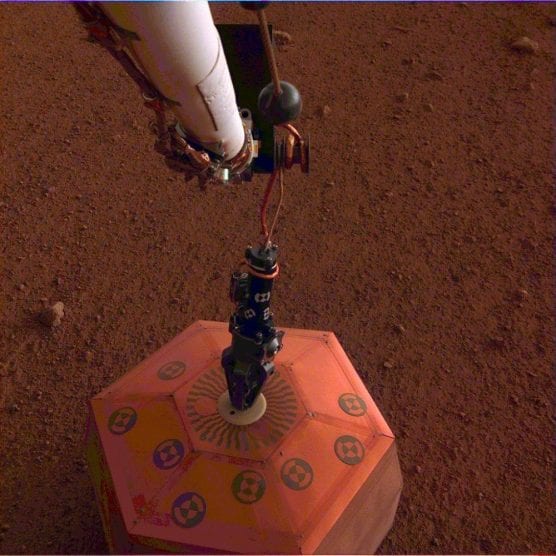By Martin Mascias Jr.
A spacecraft designed to probe the depths of Mars’ surface in order to study the origins of our universe has recorded the first Martian quake ever detected, NASA said Tuesday.
The faint “marsquake” signal was picked up by NASA’s InSight spacecraft on April 6, the lander’s 128th day, or sol, on the red planet.
The lander first touched down on Mars on Nov. 26 after a six-month, 300 million-mile journey from its launch at Vandenberg Air Force Base in California.
Scientists at NASA’s Jet Propulsion Laboratory in Pasadena, California, said in a statement Tuesday that while the signal was too small to provide new information on the Martian interior, they expect to learn more about the planet as more data are collected.
“We’ve been collecting background noise up until now, but this first event officially kicks off a new field: Martian seismology,” said NASA’s Bruce Banerdt, adding that the readings carry on the science that began with the Apollo missions’ detection of moonquakes on the lunar surface.
While Mars and the moon do not have tectonic plates – which cause quakes on Earth when they grind along fault lines – their crusts still rupture as a result of a surface-level process of cooling and contraction that causes a buildup of stress.
Philippe Lognonné of the Institut de Physique du Globe de Paris, a scientist leading research on data collected by InSight, called the seismic event an important milestone.
“We’ve been waiting months for a signal like this,” Lognonné said. “It’s so exciting to finally have proof that Mars is still seismically active. We’re looking forward to sharing detailed results once we’ve had a chance to analyze them.”
Unlike Earth’s surface, Mars’ surface is extremely quiet. This allows InSight’s copper-colored Seismic Experiment for Interior Structure instrument to pick up the faintest of rumblings.
But the instrument is also insulated within several barriers, including a shield built by JPL scientists that protects it from extreme temperature fluctuations and high winds on Mars.
NASA’s InSight likely wouldn’t operate as designed on Earth’s surface where oceans, small quakes and weather cause the ground to boom and grumble, scientists added.
On Earth, highly sensitive seismometers, such as the one used by InSight, are often are sealed in deep, underground vaults to isolate them from temperature changes and weather.
InSight’s signal is the first to have come from inside the planet, as opposed to quake signals detected above the surface caused by external forces such as wind.
The craft’s data on how quakes – which act as a kind of flashbulb illuminating the planet’s interior – pass through Mars will help scientists understand how other rocky worlds, including Earth and the moon, formed, NASA said.
Meanwhile, the project’s Rotation and Interior Structure Experiment, which does not have its own separate instrument, has already begun using InSight’s radio connection with Earth to collect preliminary data on the planet’s core.
NASA said InSight will operate on the surface for one Martian year plus 40 Martian days, or sols, until Nov. 24, 2020.
Like this:
Like Loading...
Related





 Tweet This
Tweet This Facebook
Facebook Digg This
Digg This Bookmark
Bookmark Stumble
Stumble RSS
RSS


























REAL NAMES ONLY: All posters must use their real individual or business name. This applies equally to Twitter account holders who use a nickname.
0 Comments
You can be the first one to leave a comment.